Abstract
In-situ chemical oxidation (ISCO) is a common method to remediate chlorinated ethene contaminants in groundwater. Monitoring the effectiveness of ISCO can be hindered because of insufficient observations to assess oxidant delivery. Advantageously, potassium permanganate, one type of oxidant, provides the opportunity to use its strong electrical signal as a surrogate to track oxidant delivery using time-series borehole geophysical methods, like electromagnetic (EM) induction logging. Here we report a passive ISCO (P-ISCO) experiment, using potassium permanganate cylinders emplaced in boreholes, at a chlorinated ethene contamination site, Naval Air Station Pensacola, Florida. The contaminants are found primarily at the base of a shallow sandy aquifer in contact with an underlying silty-clay confining bed. We used results of the time-series borehole logging collected between 2017 and 2022 in 4 monitoring wells to track oxidant delivery. The EM-induction logs from the monitoring wells showed an increase in EM response primarily along the contact, likely from pooling of the oxidant, during P-ISCO treatment in 2021. Interestingly, concurrent natural gamma-ray (NGR) logging showed a decrease in NGR response at 3 of the 4 wells possibly from the formation of manganese precipitates coating sediments. The coupling of time-series logging and well-chemistry data allowed for an improved assessment of passive ISCO treatment effectiveness.
1. Introduction
In-situ chemical oxidation (ISCO) uses salts of strong, soluble chemical oxidants, such as permanganate MnO4− (ion form), to oxidize anthropogenic chlorinated compounds like trichloroethylene (TCE), a chlorinated ethene, and other volatile organic compounds (VOCs) in groundwater [1]. The overall oxidation reaction [Equation (1)] creates several innocuous products such as bicarbonate, chloride, manganese and its oxides, and proton activity [2]:
4(K+ or Na+) MnO4− (aq) + 3C2HCl3 + 4H2O → 6HCO3− + 4MnO2(solid) + 4 (K+ or Na+) + 8H+ + 3Cl−
This reaction shows TCE as a dissolved contaminant phase. However, TCE in a Dense Non-Aqueous Phase Liquid (DNAPL) can be also degraded by increasing dissolution rates and accelerating mass transfer from the separate phase.
An important factor in successful ISCO treatment is the effective delivery of oxidants to contaminated zones of the aquifer where the delivery is dependent on the method used and on the subsurface conditions. For the former, there are two broad categories of delivery methods—active and passive. For the latter, an important factor in subsurface condition is the spatial distribution of hydraulic conductivity. High hydraulic conductivity is desirable for oxidant distribution [2] but other factors are important as well, such as contaminant distribution, oxidant delivery locations, rates, and concentrations, and natural sediment oxidant demand (SOD). Petri et al. [3] found an important relation between groundwater velocity, permanganate concentration, and DNAPL architecture (the shape of the DNAPL within the pore spaces of sediments) that were controlling factors in DNAPL mass depletion rates from ISCO treatment. DNAPL mass depletion rates increased with increasing groundwater velocity or increasing permanganate concentration. In contrast, the effectiveness of oxidant delivery in low-permeability units can be limited using active injection delivery methods (hydraulic-pressure based). Use of more passive treatment options is warranted in such conditions. One such passive treatment option is the use of encapsulated wax cylinders containing potassium permanganate that slowly release the oxidant over time. Slow release is desirable to enhance diffusive transport into low-permeability units allowing for a more effective delivery to target zones [4]. This scenario is often the case where DNAPL materials have migrated vertically downward through aquifers to reside in underlying lower permeability confining beds. Moreover, such scenarios create long-term problems if left untreated as contaminants in the confining bed slowly dissolve back into the overlying aquifer from back-diffusion processes [4]. It is more difficult, however, to determine the effectiveness of ISCO in low-permeability units as monitoring wells are more likely to be installed in aquifers rather than confining beds.
Surface and borehole geophysical surveys, which measure the electrical parameters of the aquifer and pore water, can enhance the spatial monitoring coverage provided by conventional well sampling, are non-invasive, and cover large areas; therefore, surveys can provide important information on the effectiveness of ISCO treatment including the ability to reach targeted zones. For example, most monitoring wells are typically partially penetrating with relatively short screens in relation to long casing sections. Water chemistry collected from these type of monitoring wells reflects the short screen section whereas several borehole geophysical methods can measure aquifer properties along the entire well (casing and screen).
The applications of time-series geophysical surveys to facilitate tracking of ISCO treatment and effectiveness have been performed by [5,6,7,8]. However, in all cases the oxidant was hydraulically injected. Injection of permanganate concentrations above 3% were found to sink in high-permeability units due to density flow and lateral spreading was limited to the contact between high-permeability units and underlying low-permeability units [6]. Emplacement of pore fluids with permanganate solution caused strong electrical responses, therefore, it was easily detectable using several geophysical methods. Injectate consisting of 0.3% to 3% solution were found to increase the bulk electrical conductivity of sands from a background of 8 mmhos-m, to 27 and 182 mmhos-m, respectively [6]. Use of other chemical oxidants such as peroxide or Fenton reagent may not have a similar electrical response and be less detectable. Therefore, coupling geophysical surveys with permanganate applications is advantageous.
Herein we provide an example of the use of borehole geophysical logging over multiple years to monitor the passive release of ISCO (P-ISCO) with potassium permanganate, mapping of oxidant movement, and evaluation of treatment effectiveness of chlorinated ethene concentrations in a low-permeability, silty-clay, confining bed at the base of a sandy aquifer, Naval Air Station (NAS) Pensacola, FL. To our knowledge, it is the first study to couple borehole geophysical logging with tracking of the passive application of ISCO treatment. The borehole geophysical logging selected for our study provided a bulk signal response and understanding the coupled responses of the pore water and sediments allowed for a more comprehensive picture of reaction mechanisms from P-ISCO.
2. Site Description
NAS Pensacola, FL is an active U.S. Navy (hereafter referred to as “Navy”) installation in coastal Escambia County, Florida (Figure 1). Operations started in 1825 as the Pensacola Navy Yard, and in 1914, NAS Pensacola became the first permanent naval air station in the United States. In 1989, NAS Pensacola was placed on the U.S. Environmental Protection Agency’s (EPA’s) National Priorities List of contaminated sites. One of these sites is a former wastewater treatment plant (WWTP), called solid waste management unit (SWMU) 1, Operable Unit 10 (OU10), located adjacent to Pensacola Bay (Figure 1). Industrial and sewage waste were treated together from 1941 to 1971. After 1971, industrial and domestic wastewater were processed separately. The WWTP was closed and demolished in 2019. On-site, unlined drying beds were used to dewater contaminated sludge and resulted in the migration of chlorinated ethenes into the shallow, sandy aquifer. Active disposal terminated in 1984 [9].
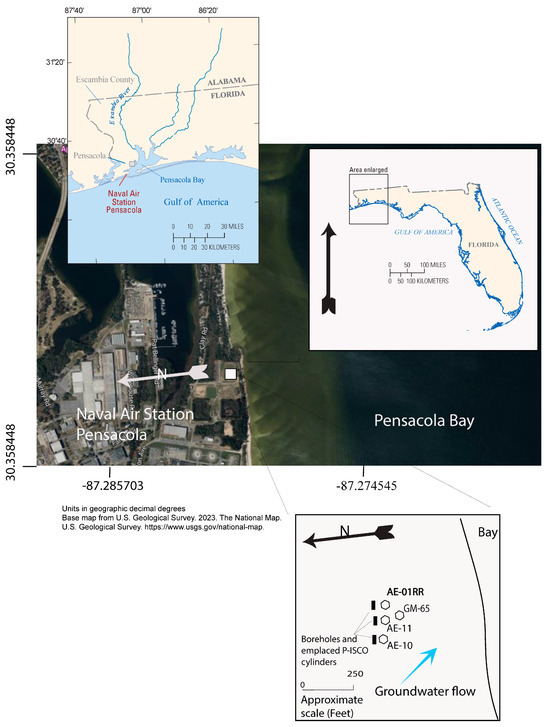
Figure 1.
Location map of Naval Air Station (NAS) Pensacola, Fl., study site, and configuration of passive in-situ chemical oxidation (P-ISCO) cylinders and monitoring wells, NAS Pensacola, FL. Blue arrow without tail is general direction of groundwater flow.
The sandy aquifer at the site is part of the uppermost layer of a regionally extensive sand and gravel aquifer of Holocene to Pliocene age (0.012 to 5.33 million of years ago); the total thickness is about 450-ft thick [10,11]. The sand and gravel aquifer was formed in a deltaic environment. In most places, the aquifer can be divided into two high-permeability units, an upper surficial and lower main producing units, separated by a less permeable silty-clay bed, which acts as a confining unit for the more regional aquifers of the area. The upper, or surficial, part of the aquifer is mostly fine- to medium-grained sand, with gravel beds and lenses. Groundwater is mostly under unconfined conditions with depths to water less than 3 ft below land surface (bls). The upper unit is recharged by precipitation, and groundwater flow is mostly lateral along flowpaths to discharge points such as Pensacola Bay (Figure 1). Due to the proximity to the Bay, groundwater levels in the site area are affected by the amplitude of the tidal cycle.
Since the early 1990s, multiple efforts were undertaken by the Navy at SWMU 1 to remediate the chlorinated ethenes in the shallow aquifer including the addition of Fenton’s oxidant reagent and vegetable oil [12,13,14]. Nonetheless, recalcitrant chlorinated ethene concentrations have remained near the base of the 45-ft thick shallow sandy aquifer and in the underlying silty-clay bed (approximately 10-ft thick), as confirmed by TCE concentrations in groundwater that ranged from 490 to 2300 micrograms per liter (µg/L) in site monitoring wells prior to our study (Table 1). Additional information and pictures of the site layout can be found at Harte et al. [15].

Table 1.
Monitoring well construction data for wells used for water-quality sampling and downhole borehole geophysical logging, Naval Air Station (NAS) Pensacola, FL. Also shown are results for chlorinated ethene concentrations in groundwater collected in 2016.
3. Methods
3.1. P-ISCO
Passive in-situ chemical oxidation (P-ISCO) implementation occurred during 7–9 July 2021 and was based on the installation of a commercially available product called SOCORE (Sustained Oxidation and Controlled Oxidant Release Encapsulants; [16]). It comprises crystalline potassium permanganate coated with a food-grade paraffin wax. SOCORE was supplied in a cylinder form (aka “candle”) about 3-inches in diameter and 24 -inches in length (Figure 2). The wax comprises between 14 and 40% of the cylinder, and the oxidant between approximately 60 to 80%. A direct push drill rig was used to create three, 4-inch diameter, 50-ft deep boreholes installed about 3-feet to the north (upgradient) from each of the three monitoring wells (AE-10, AE-11, and AE-01RR; Figure 1 and Figure 2), for a total of 9 boreholes. The boreholes were kept open with hollow rods. Each borehole received an average of about 20 pounds of wax cylinder material for a total emplacement of about 200 pounds. The majority of the 2-ft long wax cylinders were installed from 30–50 ft (9.1–15.2 m) bls, across the deeper part of the sandy aquifer and in direct contact with the silty-clay bed. The drill rods were withdrawn and the cylinders were kept in place using a centralizer. The remaining borehole space to land surface was filled with bentonite/water slurry. Emplacement of cylinders in drilled, sealed, boreholes facilitate slow dissolution rates compared to emplacement in open boreholes and wells that likely accelerates dissolution from ambient flow in the well.
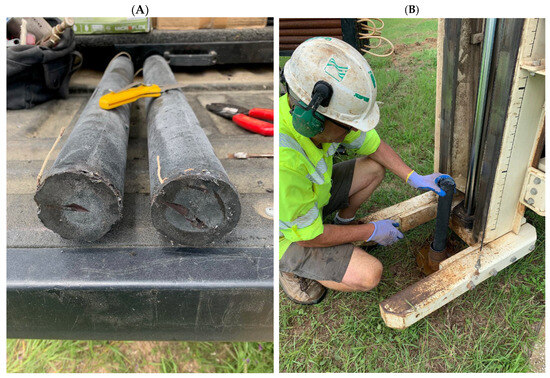
Figure 2.
Picture of Sustained Oxidation and Controlled Oxidant Release Encapsulants (SOCORE), potassium permanganate cylinder (A) and emplacement in borehole (B), 7–9 July 2021, Naval Air Station (NAS), Pensacola, FL, USA.
The Total Oxygen Demand (TOD) of the sand and clay material was determined using a permanganate loss test [17]. In general, the TOD of the sand ranged from 5.6 to 6.8 mg/kg, and the TOD of the clay was about 10 mg/kg, with the highest TOD exceeding 30 mg/kg).
3.2. Borehole Geophysical Tools
A suite of downhole geophysical logs was run in each of the three 50 ft monitoring wells in close proximity to the P-ISCO boreholes (Figure 1). In addition, a 65-ft (19.8 m) deep monitoring well (GM-65), screened in a lower sandy unit below 55-ft (15.2 m) depth, was also logged as a control well (although the screened interval is slightly deeper) (Table 1; Figure 1). The logs included natural gamma-ray (NGR) and electromagnetic (induction) conductivity (EM). The logs were collected on 8–9 August 2017 and 12 September 2018 prior to P-ISCO emplacement in early July 2021, and then again after P-ISCO implementation on 3–4 August 2021 and 19–21 September 2022. The three poly-vinyl chloride (pvc) monitoring wells are screened above and partly within the silty-clay bed (wells AE-10, AE-11, and AE-01RR) and the “control” well located nearby (23 ft distance; 7 m) that is screened below the silty-clay bed in a lower sandy uncontaminated aquifer (GM-65). Borehole EM- induction logging and NGR logging were done concurrently to identify changes in the bulk signal in the aquifer to determine if P-ISCO caused any changes from baseline conditions.
All borehole geophysical data were collected using Mount Sopris Instruments. Limitations, calibration procedures, and algorithms used by the geophysical probes during logging are available from the manufacturer [18]. All logs were collected according to the American Society of Testing and Materials borehole geophysical standard procedures [19,20,21]. Geophysical logs were collected in digital format and were recorded in the proprietary format of the data acquisition equipment used to collect the logs. These proprietary data formats were converted to and stored as log ASCII standard format [22] for tabular data. These logs are available at the U.S. Geological Survey borehole national archive site [23]. Concurrent with logging, measurements of groundwater levels, temperature, and specific conductance were made (Supplemental Tables S2–S4). Tidal data from NOAA station 8729840, Pensacola, FL. are presented in Supplemental Table S5. The supplemental datasets are also published separately in Harte et al. [15].
3.2.1. Borehole EM-Induction Logging
Electromagnetic (EM)-induction tool measures the bulk electrical conductivity of the sediments and pore fluids surrounding the borehole [20,24]. Mathematically, this can be expressed as:
where, αfm = bulk electrical conductivity of the formation or aquifer (millimhos/m),
αfm = αpf + αm
αPf = electrical conductivity of the pore water (millimhos/m), and
αm = electrical conductivity of the formation matrix (millimhos/m),
To do so, the EM tool (Geonics EM-39) uses a magnetic field to induce an electrical current in the surrounding formation. The induced current in the formation generates a secondary electromagnetic field, which is measured by the tool. At low induction numbers (less than 1000 mmhos/m), the strength of the EM field is proportional to the formation conductivity [25]. Changes in electrical conductivity are caused by variations in porosity, borehole diameter, dissolved concentration of the pore water, and metallic minerals. Electrical conductivity is also affected by the type of lithology encountered. Material in the annular space and metal centralizers used to center the well in the borehole may affect EM logs in some large boreholes. Generally, pure carbonates, sands, and gravels have lower conductivity (thus higher resistivity) than clays or shales [26,27].
The EM signal is focused to maximize vertical resolution and radial penetration and to minimize the effects of the borehole fluid [25]. The tool response is most sensitive to the formation and pore water approximately 1 ft (0.305 m) away from the probe, and the tool has a vertical resolution of approximately 2 ft (0.61 m). Thin (less than 1.64 ft (0.5 m) thick) layers with high porewater electrical conductivities exceeding 1000 µS/cm may appear as thicker layers in the EM log.
In boreholes with diameters of 6 in (15.2 cm) or less, the specific conductance of the borehole fluids has a negligible effect on the induction log response [27]. The four monitoring wells were 2-inch (50.8 mm) diameter pvc with a short screen (10 ft (3.3 m) or less in length) intervals with long solid casing risers (greater than 40 ft (10 m) in length; Table 1). Therefore, the borehole fluid circulating in monitoring wells of the site has little effect on the EM response. Borehole EM induction logging was done in the three monitoring wells (AE-10, AE-11, and AE-01RR) screened in the upper sandy unit and a fourth monitoring well (GM-65) screened in the lower sandy unit located further away (23 ft; 7 m) from the closet P-ISCO wax cylinder location (Figure 1).
EM field calibration was done daily at the site during each survey with an EM calibration ring of known conductivity and with the tool held in the air for zero conductivity. EM measurements were adjusted based on the daily calibration readings using a linear regression between the known EM calibration ring value and the EM tool reading. Coefficients of determination (R2) of 0.98 or better were maintained. Because the induction tool is temperature sensitive, the EM tool was allowed to equilibrate to borehole conditions with tool power on for at least 20 min prior to logging. EM logs were also adjusted for drift by overlying individual time series EM logs from the same well to match one another along intervals of the log unaffected by temporal change; typically, a shift was applied to ensure similar measurements between 20–30 ft (6.1–9.1 m) depth bls. Linear regression corrections and shifts applied to logs are provided in Supplemental Table S1.
Bulk electrical conductivity, as measured by EM induction logs, were compared to downhole specific conductance of groundwater at coincident vertical depths along the well screen. A linear regression was used to develop a fitted relation and assess goodness of fit. Downhole specific conductance was measured in situ at the screen interval of wells using a downhole specific conductance meter and probe (Solinst 107L). Downhole temperatures were also simultaneously recorded. The coincident collection of both EM logs and measurements of groundwater specific conductance permit calibration of the bulk electrical conductivity to the electrical properties of the pore water.
The effect of aquifer sediments on the bulk formation electrical conductivity from EM induction logging were evaluated by use of an Archie Law correction [28], which relates the formation material and aquifer pore water as such:
where, a = tortuosity (assumed to be 1 for unconsolidated sediments [29],
αfm = Cαpfθm/a
c = coefficient (=1 for shale-free rocks),
αfm = bulk electrical conductivity of the formation or aquifer (mS/m),
αpf = electrical conductivity of the pore water (mS/m),
θ = total porosity, and
m = cementation factor;
simplifying, rearranging and solving for αpF results in
log(αpf) = logαfm − mlogθ
Use of Equation (4) allows for an additional check on the dependency between the bulk formation electrical conductivity and electrical conductivity of groundwater.
3.2.2. NGR Logging
To facilitate stratigraphic mapping and to evaluate its effect on P-ISCO, NGR logs were collected in the 4 monitoring wells. Integrated interpretation of NGR logs and EM induction logging can be used to help delineate groundwater conductivity anomalies [24].
The NGR logs provide a record of gamma radiation detected at depth in a borehole and are unaffected by well fluids. A scintillation detector is used in natural gamma radioactivity tools to measure the natural gamma-ray emission from radioactive material in the rock. The primary isotopes that emit gamma radiation are potassium (K-40), uranium (U-238), and thorium (Th-232). As each of these isotopes decay, the energy released contributes to the total natural gamma radioactivity. Typically, fine-grained sediments that contain abundant clay tend to be more radioactive than coarse-grained sediments, quartz sandstones, or carbonates [27]. These logs are useful, in part, because of their versatility to function in pvc- or steel-cased wells with fluid- or air-filled boreholes and because they typically provide a good indication of layering or contacts between bedding. In this paper, NGR logs are reported in counts per second (cps), which is equivalent to American Petroleum Institute (API) gamma ray unit. The NGR logs are displayed using an approximate 2 ft (0.6 m) moving average to smooth out NGR measurements that are made every 0.1636 ft (0.05 m). In some cases, discrete measurements of NGR can contain high degrees of variance, which makes interpretation more difficult, and smoothing helps identify stratigraphic trends.
3.3. Groundwater Parameters and Chemical Constituent Sampling and Analyses
Geophysical data also were compared to pre and post P-ISCO concentrations of TCE, cis-1,2 dichloroethylene (cDCE), and vinyl chloride (VC) to identify remedial effectiveness of treatment in oxidizing these compounds in situ. Groundwater samples were collected in 2016, 2023, and 2024 by the U.S. Geological Survey and in 2021 by the Navy. All samples were analyzed for concentrations of TCE, cDCE, and VC. For all sampling events, groundwater was pumped through a low-flow chamber until measurements of physical properties and the chemical composition of the groundwater, such as dissolved oxygen, pH, specific conductance, and temperature, which were measured using a YSI 6-series sonde with a YSI 650 Multiparameter Display System (YSI, Inc., Yellow Springs, OH), had stabilized. The sonde was calibrated daily before sampling by use of appropriate standard methods for dissolved oxygen, specific conductance, and pH, as reported in the U.S. Geological Survey National Field Manual for the Collection of Water-Quality Data [30]. Groundwater samples did not require filtration because of the low turbidity (less than 5 nephelometric turbidity units [NTU] as measured using the YSI 650). Groundwater samples for the determination of chlorinated ethene concentrations were collected in 40 milliliter (mL) amber vials in triplicate. The vials were preserved to a pH of 2 with a 1:1 solution of hydrochloric acid and chilled. For samples in 2021, water samples taken for analysis of VOCs were analyzed at Advanced Environmental Laboratories, Inc. in Jacksonville, Florida using EPA Method 8260 [31]. Similar, for samples in 2016, 2023, and 2024, water samples taken for the analysis of VOCs were analyzed at the U.S. Geological Survey NWQL contract laboratory, in Denver, Colorado, using the EPA Method 8260 [31]. The minimum reporting limits (MRL) of each constituent are reported with the results. Samples were also collected and analyzed for manganese using EPA Method SW6010D [32]. Concurrent with logging and groundwater sampling, measurements of groundwater levels, temperature, and specific conductance were made.
4. Results
4.1. Borehole Geophysical Logs
Background logs collected during 2017 and 2018 (prior to P-ISCO) indicate the stratigraphy of the site is planar with little slope, similar to the slope of the land surface. Depth to groundwater is shallow (less than 3 ft (0.9 m) bls), hydraulic gradients are relatively flat (an apparent gradient of 0.054; Supplemental Table S2), and groundwater levels show little fluctuation during data collection periods, which were typically in the late summer (Figure 3, Figure 4, Figure 5 and Figure 6; Supplemental Table S2). The upper sands are contiguous from land surface to a depth of approximately 40–44 ft (12.2 m) bls. The upper sands are clean and relatively homogeneous with low readings from the NGR and EM logs (Figure 3, Figure 4, Figure 5 and Figure 6). From 35 to 44 ft (10.7–13.4 m) bls an increase in the EM log suggests a slight fining-downward sequence. It is likely that there are thin layers (1–3 ft (0.61–1.83 m)) of silty clay at depths of 44 ft to 55 ft (12.2–16.8 m) bls. The depth of inflections and increases in the NGR and EM logs concur with drilling logs and cores that suggest the presence of silty clay is primarily from 45 ft (13.7 m) to 50 ft (15.2 m) depth bls. The NGR and EM logs at well GM-65 (deep well) suggest another clean sand layer is present below 55 ft (16.8 m) depth bls (Figure 3).
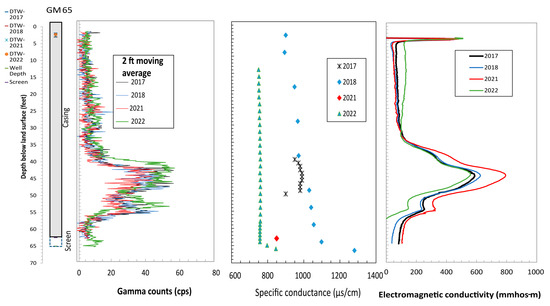
Figure 3.
Logs of natural gamma-ray (NGR) and electromagnetic (EM) induction, and specific conductance values for well GM-65, Naval Air Station (NAS) Pensacola, FL. [NGR logs use a 2-ft moving average smoothing method; well GM-65 is screened in the lower sand unit and specific conductance values are lower by an order of magnitude than the wells AE-10, AE-11, and AE-01RR]. Depth to water table (DTW) 3 feet below land surface.
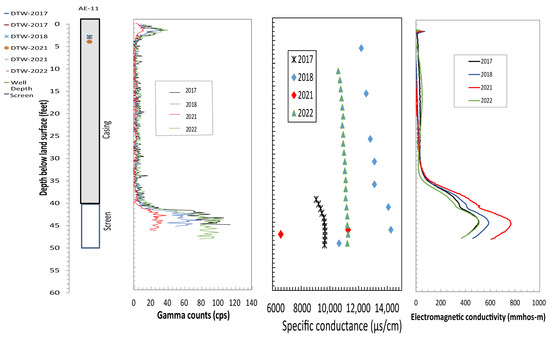
Figure 4.
Logs of natural gamma ray (NGR) and electromagnetic (EM) induction, and specific conductance values for well AE-11, Naval Air Station (NAS) Pensacola, FL. [NGR logs use a 2-ft moving average smoothing method]. Depth to water table (DTW) 3 feet below land surface.
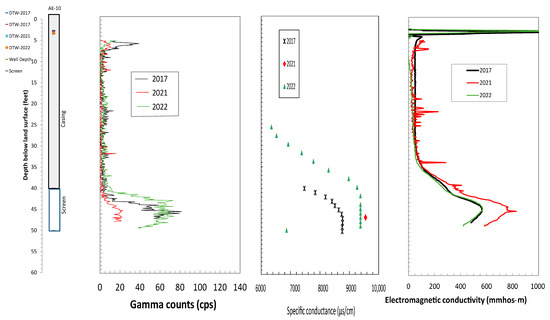
Figure 5.
Logs of natural gamma ray (NGR) and electromagnetic (EM) induction, and specific conductance values for well AE-10, Naval Air Station (NAS) Pensacola, FL. [NGR logs use a 2-ft moving average smoothing method]. Depth to water table (DTW) 3 feet below land surface.
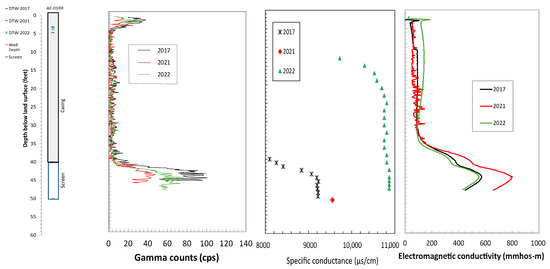
Figure 6.
Logs of natural gamma ray (NGR) and electromagnetic (EM) induction natural-gamma ray (NGR) and electromagnetic (EM) induction, and specific conductance values for well AE-01RR, Naval Air Station (NAS) Pensacola, FL. [NGR logs use a 2-ft moving average smoothing method]. Depth to water table (DTW) 3 feet below land surface.
Differences in the NGR and EM logs from possible changes in temporal ambient flow (unrelated to ISCO) are likely small. The background logs from 2017 and 2018 indicate minor variability in bulk responses of the NGR and EM logs although the tidal cycle at Pensacola Bay (Supplemental Table S5) likely affected groundwater levels between the 2017 (higher tide) and 2018 (lower tide) site visits (Supplemental Table S5). Concurrently, groundwater levels at well GM-65 were approximately 1 ft (0.305 m) lower in 2018 than 2017 corresponding to the changes in the tidal cycle (Supplemental Table S2). Tidal influence on groundwater is a common feature of coastal environments [33]. The tidal cycles after implementation of P-ISCO in 2021 and 2022 (at 1100 CST) were similar in 2021 and in 2022 (Supplemental Table S5). Differences in groundwater levels at well GM-65 were approximately 0.6 ft (0.20 m) with 2021 higher than 2022 (Supplemental Table S2) indicating rates of groundwater recharge were likely higher in 2021 than 2022.
In contrast, 1 month after P-ISCO in July 2021, the logs show the highest EM conductivity recorded but the lowest NGR values recorded compared to the background (2017–18) and to that measured 1 year after P-ISCO in 2022. All EM and NGR logs are approximately 25% different in 2021 than the other years except for the NGR log at well GM-65, which shows little yearly change (Figure 3). Of the three shallow wells, the greatest difference is in the NGR log for well AE-11 (Figure 4) and the least at AE-10 (Figure 5). Well GM-65, being farthest away from the P-ISCO cylinders (approximately 23 ft, 0.7 m), and its screen is isolated from the shallow aquifer by the silty-clay bed, shows no evidence of transport of permanganate in 2021 at the screen interval around 60 ft (18.3 m) bls but some minor transport along the upper sandy to silty-clay contact at 44 ft (13.4 m) bls. Further, groundwater-levels indicate potential for upward flow from GM-65 to the shallower wells (AE-10, AE-11, and AE-01RR; Supplemental Table S2), which would help isolate the middle sand unit below 55 ft (16.8 m) bls from appreciable permanganate ion transport from the upper sandy unit or diffusion from the silty-clay bed.
The 2022 logs (both EM and NGR) from all wells show results similar to those measured prior to P-ISCO (Figure 7; Supplemental Table S3). This indicates reactions from the P-ISCO are likely complete or the permanganate ion is minimized in spatial extent, the P-ISCO wax cylinders are mostly depleted, and reaction byproducts have been transported away.
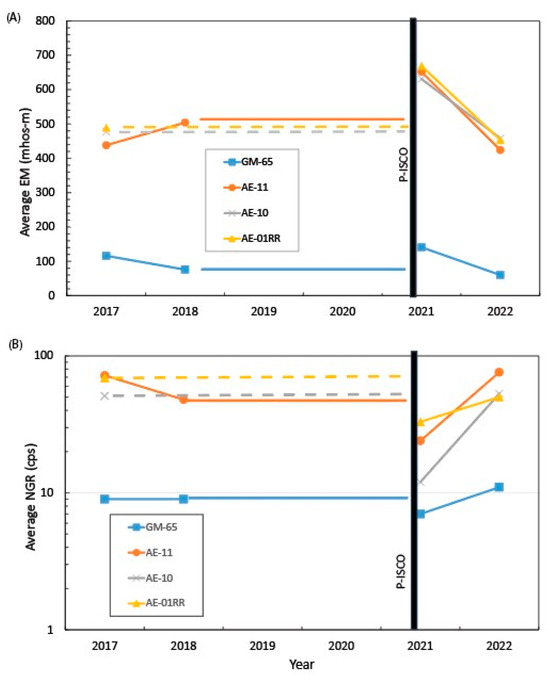
Figure 7.
Average electromagnetic (EM)-induction log (A) and natural gamma-ray (NGR) log (B) results for the well screens, Naval Air Station (NAS) Pensacola, Florida. [EM-induction log and NGR log have an inverse response to July 2021 passive in-situ chemical oxidation (P-ISCO). Average values determined from screen intervals].
The fact that little vertical change in the EM and NGR logs was observed beyond the contact and within the silty-clay bed (<44 to 55 ft; 13.41 to 16.77 m bls) indicates the lateral spread of the permanganate ion and reaction byproducts in the upper sandy unit are mostly limited to that zone near the contact and in the silty-clay bed. Given that the silty-clay bed acts as a residual chlorinated ethene (e.g., TCE) source, lateral spreading along the contact is advantageous where it can diffuse into the silty-clay bed. Permanganate from P-ISCO implementation into a low-permeability aquifer [4] and from active delivery at 3% solution [6] has been shown to be partly governed by density flow promoting preferential spreading along contacts of high- and low-permeability geologic units.
4.2. Relation of Formation and Fluid Responses
Bulk electrical conductivities of the formation (αfm; Equations (2) and (4)), as measured by EM induction logging, were compared to measured groundwater specific conductance for background levels recorded prior to P-ISCO (2017 and 2018) to establish linear regression statistics and to validate the dependence of bulk electrical conductivities on groundwater electrical conductivities (specific conductance). Supplemental Material Tables S3 and S4 contain specific conductance data of groundwater from the monitoring wells. An R2 of 0.91 between EM induction conductivities and measured groundwater specific conductance from 2017–2018 was computed from a linear regression of 8 coupled readings. The linear statistic showed a normal standardized residual and was significant at the 95% confidence level. Therefore, groundwater specific conductance, in µS/cm (microsiemens per cm), can be computed from the bulk electrical conductivities of the formation, as measured by EM induction logs, in mS/m by:
where GWsc is the predicted specific conductance of groundwater (µS/cm), as derived from the EM log conductivity [αfm; Equation (4)].
GWSC = −1550.4 + 25.125(EM log conductivity);
The linear regression shows considerable scatter when bulk formational and groundwater electrical conductivities from 2021 after P-ISCO implementation are incorporated. For the 2021 P-ISCO affected wells (AE-10, AE-11, and AE-01RR), an R2 of 0.75 between EM induction conductivities and groundwater electrical conductivities results. The decrease in R2 fitness indicates that formational electrical conductivity changes on solids are occurring from the P-ISCO in addition to changes in pore-water chemistry.
Application of an Archie’s Law [Equation (4)] using EM log results from AE-11 for 2017 pre P-ISCO and 2021 post P-ISCO, which shows a strong EM log response, and comparing to groundwater electrical conductivities from the same well [αpf; Equation (4)] as a calibration point, resulted in the calculated cementation factor (m) range of 0.68–1.08 for 2017 and 0.4–0.92 for 2021 (Table 3). Differences in cementation factor (m) result from selection of αfm values that are representative of three scenarios: the upper sandy unit, a bimodal representation, and the silty-clay bed. The aquifer total porosity (Ɵ) was computed at 0.38 after trial and error calculations to match measured αfm values from the EM log and further constrained by reported ranges of likely total porosity of sands [26]. Jackson et al. [33] reported a cementation factor (m) of 1.5 for marine sands and Harte et al. [6] reported a cementation factor of 1.4 for glacial fluvial deposits.
The cementation factors [m; Equations (3) and (4)] for the site are low and particularly low when matching the peak EM log response from the silty-clay bed (representing a depth of 45 ft (13.7 m) bls) to the groundwater electrical conductivities from the wells (Table 2). The most realistic cementation factors computed, near a value of 1, result when comparing the low EM log response from the upper sandy unit (representing a depth of 40 ft (12.2 m) bls) to the groundwater specific conductance from the well. The bimodal scenario yields an m between the other scenarios. Results indicate that the specific conductance of groundwater measured in the wells is representative of the upper sands and not the silty-clay bed despite the well screen cutting across both units. This interpretation is supported by the likely differential inflow rates between the two units given the permeability differences. Therefore, well screens set only in the silty-clay bed would yield a higher groundwater specific conductance than that measured from the current wells that are screened across both units.

Table 2.
Computed Archie parameters from electromagnetic (EM) induction log for well AE-11, Naval Air Station (NAS) Pensacola, Fl.
4.3. Comparison of Logging Signatures to Chlorinated Ethene Concentrations
After P-ISCO addition, TCE, cDCE, and VC concentrations declined in groundwater in 2 (AE-11 and AE-01RR) of the 3 wells adjacent to the emplaced cylinders (Table 3; Figure 8). In contrast, well AE-10 has exhibited minor changes and in fact showed some increases in TCE immediately post P-ISCO. This may be because groundwater sampled from AE-10 is characterized by a lower pH than the other wells, caused by the former release of concentrated sulfuric acid to the aquifer [12]. Permanganate reactions in such low pH groundwater may have produced high concentrations of Mn2+ in groundwater at the expense of permanganate (Table 3). Further, the position of AE-10 is slightly upgradient of the other wells and is receiving untreated (with regard to permanganate) groundwater from upgradient areas (Figure 1 inset).
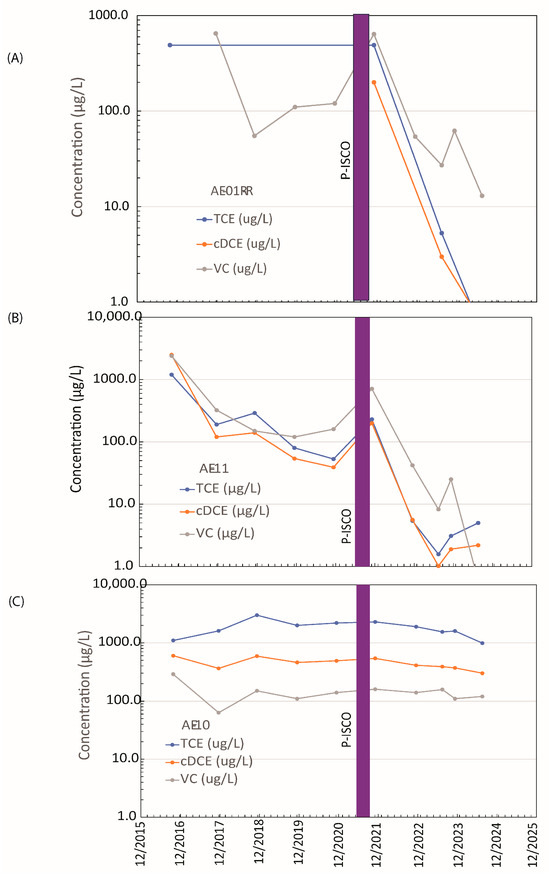
Figure 8.
Graphs of chlorinated ethene concentrations in micrograms per liter (µg/L) from monitoring wells AE-01R-R (A), AE-11 (B), and AE-10 (C), Naval Air Station (NAS) Pensacola, FL. TCE is trichloroethylene, cDCE is cis-1,2-dichloroethylene, VC is vinyl chloride.
Dissolved manganese (Mn) concentrations in groundwater have decreased from maximum values in 2021 and 2023 to lower values in 2024 (except at AE-10; Table 3). Solid Mn production is a P-ISCO byproduct from the reaction [Equation (1)]. Mn coatings on sediments in 2021, 29 days after post P-ISCO, are a likely reason for the decrease in NGR logs for that year.

Table 3.
Chlorinated ethene concentrations from monitoring wells, Naval Air Station (NAS) Pensacola, FL.
Table 3.
Chlorinated ethene concentrations from monitoring wells, Naval Air Station (NAS) Pensacola, FL.
| Well | Date | Total Dissolved Solids (mg/L) | Specific Conductance (µS/cm) | Manganese (µg/L) | TCE (µg/L) | cDCE (µg/L) | Vinyl Chloride (µg/L) |
|---|---|---|---|---|---|---|---|
| AE-11 | |||||||
| 26 September 2016 | -- | -- | -- | 1200 | * 2500 | * 2400 | |
| 2 November 2021 | 10,000 | 10,931 | 42 | -- | -- | 0.44 J | |
| 14 July 2023 | 6300 | 8912 | 68 | 1.58 | 1.02 | 8.25 | |
| 17 July 2024 | 6130 | 8861 | 14 | 5 | 2.2 | 0.6 | |
| AE-10 | |||||||
| 26 September 2016 | -- | -- | -- | 1100 | -- | -- | |
| 2 November 2021 | 79,000 | 8340 | 3400 | 2300 | 540 J | 160 | |
| 14 July 2023 | 7910 | 8131 | 32,000 | 1548 | 389.2 | 158 | |
| 17 July 2024 | 8720 | 7932 | 43,000 | 990 | 300 | 120 | |
| AE-01RR | |||||||
| 26 September 2016 | -- | -- | -- | 490 | -- | -- | |
| 2 November 2021 | 100,000 | 11,710 | 44 | 490 | 200 J | 640 J | |
| 14 July 2023 | 6500 | 8965 | 28 | 5.28 | 2.99 | 27.1 | |
| 17 July 2024 | 5720 | 8973 | 20 | 0.49 | 0.6 | 13 |
mg/L is milligrams per Liter; µS/cm is microsiemens per centimeter; µg/L is micrograms per liter. * represents maximum value from that year. J indicates the compound was detected greater than the method detection level but less than the reporting limit. TCE is trichloroethylene; cDCE is cis-1,2-dichloroethylene; --, is no data.
5. Discussion
Both the NGR and EM logs showed significant change (approximately 25% change in values from pre P-ISCO to post P-ISCO) at all of the monitoring wells in the contaminated shallow aquifer and underlying confining bed (excluding the NGR log at well GM-65). Logging indicates localized coverage of the permanganate (in aqueous or ion form; Equation (1)) along or near the contact between the sandy unit and underlying silty-clay bed; the chlorinated ethene source is found in the silty-clay bed. There is little lateral spread of the permanganate ion between 30–40 ft (9.1–12.2 m) depth bls despite the SOCORE being emplaced from 30–50 ft (9.1–15.2 m) depths. The lateral distance between the emplaced SOCORE and the detection distance of the EM tool, which has an optimal measurement distance from the logged well of 1 ft (30.5 cm), is approximately 22 inches (55.9 cm). Therefore, a daily spread rate of 0.068 ft/d (2.1 cm/d) would be needed for the EM tool to detect permanganate ion transport, which it did not detect at those depths from 30–40 ft (9.1–12.2 m) depth bls. We attribute this to the importance of density driven flow because permanganate has a specific gravity greater than 1 and its transport is likely to be vertical downward in the upper sandy unit until pooling atop of the contact with the underlying silty-clay bed at approximately 44–45 ft bls. Transport laterally and vertically in the silty-clay bed itself is likely slow given that permanganate diffusion rates of 0.17 ft/d (5.2 cm/d) have been reported for similar lithologies [4]. However, this rate is fast enough to allow for detection of permanganate in the silty-clay bed from the emplaced boreholes laterally to the adjacent wells at AE-11, AE-10, AE-01RR but not at GM-65.
While the EM logs respond to the bulk electrical conductivities of the formation [αfm; Equation (2)] and the presence of the permanganate or breakdown products such as Cl− from the reaction [Equation (1)], the NGR logs are responding to decreases in gamma emitters of K-40, U-238, and Th-232. We conclude from the logging data and groundwater analyses that Mn(s) is coating the aquifer formation sediments in 2021 (29 days after the SOCORE emplacement) and, therefore, the coating serves to dampen the NGR signal, particularly within the silty-clay bed. The reaction reported in Equation (1) is rapid and likely happens within days [7]. Further, Mn oxides can form in mildly reducing subsurface conditions. Because this is a newly hypothesized observation, and other processes such as coating of non-radioactive K onto sediments also maybe a possibility in dampening the NGR signal, further research is warranted to investigate these hypothesized processes. In contrast, negligible changes in the NGR log in 2021 for well GM-65 suggest dampening does not occur within the silty-clay bed at this location because diffusion transport rates within the silty-clay bed are too slow to arrive in time at this location.
The decreases in TCE, cDCE, and VC concentrations at 2 shallow wells (AE-11, AE-01RR) adjacent to the P-ISCO emplacements support the time series responses of the NGR and EM logs that permanganate has spread to zones adjacent to those wells along the contact and laterally and vertically via diffusive transport in the silty-clay bed (Figure 9). At a third well (AE-10) low pH may have hindered permanganate reaction with contaminants. Future groundwater sampling for TCE and reaction byproducts beyond 2024 will help assess the effectiveness of the P-ISCO in attacking chlorinated ethene (e.g., TCE) source from the silt-clay bed.
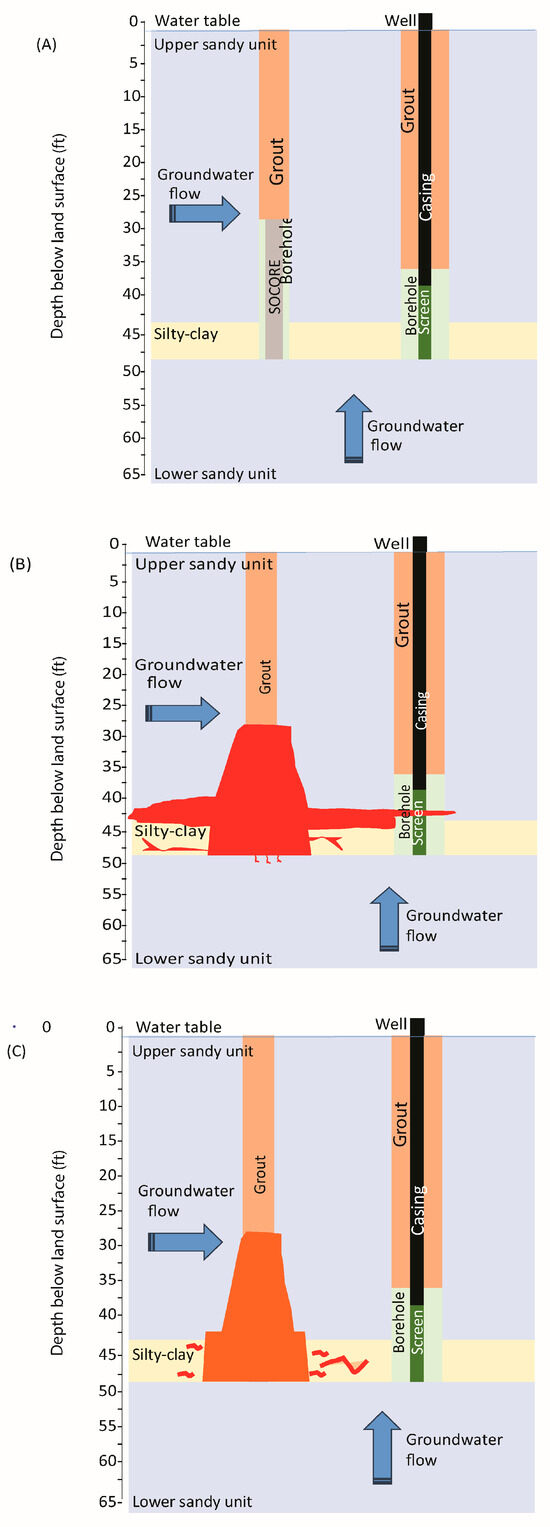
Figure 9.
Conceptual illustration of passive in-situ chemical oxidation (P-ISCO) transport over time during installation (A), 1 month after P-ISCO (B), and 1 year after (C) for the P-ISCO experiment, Naval Air Station (NAS), Pensacola, FL, USA.
Implementation of P-ISCO at sites with similar stratigraphy and underling low-permeability units (the “universal confining layer” that seems to be present at many contaminated sites [34]) may benefit from the passive release of permanganate that likely allows for additional diffusive transport into adjacent low-permeability units. Hydraulic-based injections of permanganate, unless they are slow release, would likely be transported via advection processes away from target zones thereby limiting the ability for diffusive transport into low-permeability units. Dissolution rates and sizes of P-ISCO cylinders should be carefully considered to optimize target of low-permeability zones with TCE sources. Emplacement of cylinders in drilled boreholes also seemed to allow for a dispersal rate beneficial for the spread along the contact and subsequent diffusion into the silty-clay bed. Unlike our work, disbursement from emplacement of cylinders within wells is dependent on ambient flow conditions in the well and may promote preferential flow within high permeability units [35]. Understanding the natural oxidant demand (NOD) of the system is also important [36]. In our case, decreases in chlorinated ethene concentrations years after P-ISCO application, without a rebound in concentrations indicates that successful disbursement of oxidant, adequate dosage to overcome NOD, and diffusion into the silty-clay bed have occurred.
Coupled time-series borehole geophysical logging and groundwater quality monitoring provides a more comprehensive analysis approach to evaluating the effectiveness of ISCO and permanganate applications. Borehole EM logging responds to the bulk formational properties of the aquifer and confining bed. Therefore, reactions to the solids and pore water from ISCO can be monitored. Calculated cementation factors [m; Equation (4)] from our study more closely matched values from previous studies when the assumption is made that the groundwater conductivity measured within the monitoring well is being dominated by pore water chemistry of the upper sandy unit; our analysis illustrates the complexity of wellbore flow dynamics in monitoring wells cross cutting heterogeneous formations.
6. Conclusions
The coupled time-series, electromagnetic (EM)-induction and natural-gamma-ray (NGR) logging in monitoring wells at a chlorinated ethene (trichloroethylene (TCE), cis1,2-dichloroethene (cDCE), and vinyl chloride (VC)) contamination site at Naval Air Station (NAS) Pensacola, Florida showed that potassium permanganate coverage from P-ISCO (Passive In-situ Chemical Oxidation) deployment spread to all of the monitoring wells in the shallow contaminated sandy aquifer along the contact between the upper sand unit and underlying silty-clay bed. The understanding of the stratigraphy of a site and locations of geologic contacts is important when applying ISCO because of the tendency of the permanganate to be controlled by density-driven flow and pooling along contacts is common.
Most logs showed an inverse response where the NGR log showed a decrease in gamma emissions during the P-ISCO treatment period in 2021 whereas the EM log showed an increase. While it was anticipated that an increase in the bulk electrical conductivity of the formation would occur, the response of the NGR log shed new light on processes associated with P-ISCO. Specifically, the NGR logs are responding to decreases in gamma emitters of potassium (K-40), uranium (U-238), and thorium (Th-232) that we conclude results from the creation of Mn coatings onto sediments that buffer the gamma signal. Potassium (K) coatings onto sediments also are a potential reason if K generated from the K-permanganate cylinders contain less K-40 isotopes than that from the natural K in sediments. Based on the NGR logs and location of the wells, the dampening process likely originates in the silty-clay bed.
The release and movement of permanganate into the aquifer and underlying confining silty-clay bed as shown by the time-series logging is primarily confirmed by the observed decreases in concentrations of TCE, cDCE, and VC at two of the three shallow wells in close proximity to the emplaced P-ISCO cylinders. Based on the logging, the P-ISCO application spread preferentially near the contact, from density-induced flow, between the upper sandy unit and the underlying silty-clay bed, and within the silty-clay bed itself. Apparent rates of transport of permanganate ion along the contact range from 0.068 to 0.76 ft/d (0.021 to 0.23 m/d). The focused spreading has advantages in that it allows for optimal contact with likely chlorinated ethene sources in the silty-clay bed. Further, slow dissolution rates of the P-ISCO cylinder, emplaced in nearby drilled boreholes, likely allow for initiation of diffusive transport into the underlying silty-clay bed. While determination of diffusion rates into the silty-clay bed were beyond the scope of this study, performance metrics based on contaminant concentration declines and borehole geophysical signatures indicate successful delivery of oxidant to contaminated zones.
Supplementary Materials
The following supporting information can be downloaded at: https://www.mdpi.com/article/10.3390/hydrology12060155/s1, Table S1. Borehole geophysical log corrections for electromagnetic (EM) induction and natural gamma-ray (NGR) logs, Naval Air Station Pensacola, Florida. Table S2. Groundwater levels and well soundings for monitoring wells, NAS Pensacola, FL. Table S3. Average borehole log (EM, NGR) responses and water conductivity for the screen interval of monitoring wells, NAS Pensacola, FL. Table S4. Downhole specific conductance and water temperature from monitoring wells at NAS Pensacola, FL. Table S5. Tidal cycles for NOAA station 8729840, Pensacola, FL.
Author Contributions
The P-ISCO experiment was conceived and implemented by J.E.L. and M.A.S. The monitoring design was jointly conceived by P.T.H. and J.E.L. The collection and processing of borehole geophysical logs were done by P.T.H. The well chemistry data were collected by J.E.L. The manuscript was written by P.T.H. with assistance from J.E.L. All authors have read and agreed to the published version of the manuscript.
Funding
This research was funded by the U.S. Navy Naval Facilities Engineering Systems Command Southeast.
Data Availability Statement
The Supplemental Tables and raw borehole geophysical logs can be found in a U.S. Geological Survey data release (https://doi.org/10.5066/P13UDD4V) [15]. Logs can also be found at the U.S. Geological Survey borehole national archive site at https://www.usgs.gov/tools/geolog-locator.
Acknowledgments
Prepared in cooperation with the U.S. Navy Naval Facilities Engineering Systems Command Southeast. Any use of trade, product, or firm names is for descriptive purposes only and does not imply endorsement by the U.S. Government.
Conflicts of Interest
The authors declare no conflicts of interest.
Abbreviations
The following abbreviations are used in this manuscript:
| P-ISCO | Passive In-Situ Chemical Oxidation |
| NASJ | Naval Air Station |
| NGR | Natural Gamma Ray |
| TCE | Trichloroethylene |
| VOC | Volatile Organic Compound |
| DNAPL | Dense Non-Aqueous Phase Liquid |
| SOD | Sediment Oxygen Demand |
| SOCORE | Sustained Oxidation and Controlled Oxidant Release Encapsulants |
| WWTP | Waste Water Treatment Plant |
| SWMU | Solid Waste Management Unit |
| TOD | Total Oxidant Demand |
| USGS | United States Geological Survey |
| NWQL | National Water Quality Laboratory |
| EM | Electromagnetic |
| NOD | Natural Oxidant Demand |
| NWIS | National Water Information System |
References
- ITRC (Interstate Technology & Regulatory Council). Technical and Regulatory Guidance for In Situ Chemical Oxidation of Contaminated Soil and Groundwater, 2nd ed.; The Interstate Technology & Regulatory Council In Situ Chemical Oxidation Team: Washington, DC, USA, 2005; p. 172. Available online: https://itrcweb.org/wp-content/uploads/2024/09/ISCO-2.pdf (accessed on 1 May 2009).
- Cave, L.; Hartog, N.; Al, T.; Parker, B.; Mayer, K.U.; Cogswell, S. Electrical monitoring of In Situ chemical oxidation by permanganate. Ground Water Monit. Remediat. 2007, 27, 77–84. [Google Scholar] [CrossRef]
- Petri, B.G.; Siegrist, R.L.; Crimi, M.L. Effects of groundwater velocity and permanganate concentration on DNAPL mass depletion rates during in situ oxidation. J. Environ. Eng. 2008, 134, 13. [Google Scholar] [CrossRef]
- Christenson, M.D.; Kambhu, A.; Comfort, S.D. Using slow-release permanganate candles to remove TCE from a low permeability aquifer at a former landfill. Chemosphere 2012, 89, 680–687. [Google Scholar] [CrossRef] [PubMed]
- Albano, J.; Comfort, S.D.; Zlotnik, V.; Halihan, T.; Burbach, M.; Chokejaroenrat, C.; Onanong SClayton, W. In Situ Chemical Oxidation of RDX-Contaminated Groundwater with Permanganate at the Nebraska Ordnance Plant. Ground Water Monit. Remediat. 2010, 30, 96–106. [Google Scholar] [CrossRef]
- Harte, P.T.; Smith, T.E.; Williams, J.H.; Degnan, J.R. Time Series Geophysical Monitoring of Permanganate Injections and In-situ chemical Oxidation of PCE, OU1 area, Savage Superfund Site, Milford, NH, USA. J. Contam. Hydrol. 2012, 132, 58–74. [Google Scholar] [CrossRef] [PubMed]
- Han, Z.; Kang, X.; Singha, K.; Wu, J.; Shi, X. Real-time monitoring of in situ chemical oxidation (ISCO) of dissolved TCE by integrating electrical resistivity tomography and reactive transport modeling. Water Res. 2024, 252, 121195. [Google Scholar] [CrossRef] [PubMed]
- Bording, T.; Kuhl, A.K.; Fiandaca, G.; Christensen, J.F.; Christiansen, A.V.; Auken, E. Cross-borehole geoelectrical time-lapse monitoring of in situ chemical oxidation and permeability estimation through induced polarization. Near Surf. Geophys. 2021, 19, 43–58. [Google Scholar] [CrossRef]
- Ensafe/Allen and Hoshall. Final Record of Decision, Operable Uniot 10, NAS Pensacola, Fl.; Ensafe/Allen and Hoshall: Memphis, TN, USA, 1997; p. 113. [Google Scholar]
- Andrews, W.J. Ground-water quality and trends at two industrial wastewater-injection sites in northwestern Florida, 1975–1991. In U.S. Geological Survey Water-Resources Investigations Report; US Geological Survey: Reston, VA, USA, 1994; Volume 93, p. 25. [Google Scholar]
- Miller, J.A. Ground Water Atlas of the United States: Alabama, Florida, Georgia, and South Carolina; Hydrologic Atlas 730; U.S. Geological Survey: Reston, VA, USA, 1990; Chap. G; pp. G1–G28. [Google Scholar] [CrossRef]
- Bradley, P.M.; Singletary, M.A.; Chapelle, F.H. Chloroethene dichlorination in acidic groundwater: Implications for combining Fenton’s treatment with natural attenuation. Remediation 2007, 18, 7–19. [Google Scholar] [CrossRef]
- Chapelle, F.H.; Bradley, P.M.; Thomas, M.A.; McMahon, P.B. Distinguishing iron-reducing from sulfate-reducing conditions. Groundwater 2009, 47, 300–305. [Google Scholar] [CrossRef] [PubMed]
- Chapelle, F.H.; Singletary, M.A. Combining Source-Area Treatment with MNA: A Tale of Two Sites. Groundwater 2010, 48, 803–805. [Google Scholar]
- Harte, P.T.; Landmeyer, J.E.; Welch, S.M. Datasets for Monitoring of a P-ISCO Experiment to Remediate a Chlorinated Ethene Plume, NAS Pensacola, Florida; U.S. Geological Survey Data Release: Reston, VA, USA, 2025. [Google Scholar] [CrossRef]
- SE Sciences Inc. Encapsulated Environmental Reactants. Available online: https://www.sesciences.com/environmental/waterremediation/ (accessed on 15 September 2024).
- ASTM D7262-10; Standard Test Method for Estimating of the Permanganate Natural Oxidant Demand of Soil and Aquifer Solids. American Society of Testing and Materials: West Conshohocken, PA, USA, 2016.
- Mount Sopris Instruments. 2018. Available online: https://mountsopris.com/ (accessed on 2 January 2018).
- ASTM D6767-97; Standard Guide for Conducting Borehole Logging—Mechanical Caliper. American Society of Testing and Materials: West Conshohocken, PA, USA, 2004; p. 6.
- ASTM D6726-01; Standard Guide for Conducting Borehole Geophysical Logging—Electromagnetic Induction. American Society of Testing and Materials: West Conshohocken, PA, USA, 2007; p. 8.
- ASTM D5753-05; Standard Guide for Planning and Conducting Borehole Geophysical Logging. American Society of Testing and Materials: West Conshohocken, PA, USA, 2010; p. 9.
- Canadian Well Logging Society. Log ASCII Standard (LAS): Canadian Well Logging Society Web Page. 2013. Available online: http://www.cwls.org/ (accessed on 8 May 2013).
- US Geological Survey. Borehole Geophysical National Archiver Site; US Geological Survey: Reston, VA, USA, 2024. Available online: https://webapps.usgs.gov/GeoLogLocator (accessed on 8 November 2024).
- Williams, J.H.; Lapham, W.W.; Barringer, T.H. Application of electromagnetic logging to contamination investigations in glacial sand and gravel aquifers. Ground Water Monit. Remediat. Rev. 1993, 13, 129–138. [Google Scholar] [CrossRef]
- McNeill, J.D.; Bosnar, M.; Snelgrove, F.B. Resolution of an Electromagnetic Borehole Conductivity Logger for Geotechnical and Ground Water Applications; Technical Note, TN-25; Geonics Limited: Mississauga, ON, Canada, 1990; p. 28. [Google Scholar]
- McNeill, J.D. Electrical Conductivity of Soils and Rocks; Technical Note, TN-5; Geonics Limited: Mississaugua, ON, Canada, 1980; p. 22. [Google Scholar]
- Keys, W.S. Borehole geophysics applied to water-resources investigations. In U.S. Geological Survey Techniques of Water Resources Investigations; US Geological Survey: Reston, VA, USA, 1990; Book 2, Chap. E2; p. 150. [Google Scholar]
- Archie, G.E. The electrical resistivity log as an aid in determining some reservoir characteristics. Pet. Trans. AIME 1942, 146, 54–62. [Google Scholar] [CrossRef]
- US Geological Survey. National field Manual for the Collection of Water-Quality Data; U.S. Geological Survey Techniques and Methods: Reston, VA, USA, 2020; Book 9, Chaps. A1–A10, [variously paged]. Available online: http://pubs.water.usgs.gov/twri9A (accessed on 3 September 2020).
- U.S Environmental Protection Agency. Method 8260D (SW-846): Volatile Organic Compounds by Gas Chromatography/Mass Spectrometry (GC/MS); Revision 3; U.S Environmental Protection Agency: Washington, DC, USA, 2006. Available online: https://www.epa.gov/esam/epa-method-8260d-sw-846-volatile-organic-compounds-gas-chromatography-mass-spectrometry-gcms (accessed on 23 September 2024).
- US EPA. Method 6010D (SW-846): Inductively Coupled Plasma-Atomic Emission Spectrometry; Revision 4; U.S. EPA: Washington, DC, USA, 2014. Available online: https://www.epa.gov/esam/epa-method-6010d-sw-846-inductively-coupled-plasma-atomic-emission-spectrometry (accessed on 23 September 2024).
- Barlow, P. Ground Water in Freshwater-Saltwater Environments of the Atlantic Coast; U.S. Geological Survey Circular 1262; US Geological Survey: Reston, VA, USA, 2003. [Google Scholar] [CrossRef]
- Jackson, P.D.; Taylor-Smith, D.; Stanford, P.N. Resistivity-porosity-particle shape relationships for marine sands. Geophysics 1978, 43, 1250–1268. [Google Scholar] [CrossRef]
- Stone, P.A. The Universal Confining Layer: A Critical Crypto-Protector of Our Precious Groundwater. 2016. Available online: https://www.researchgate.net/publication/303446366_The_Universal_Confining_Layer_A_critical_crypto-protector_of_our_precious_groundwater?channel=doi&linkId=5743612608ae9ace841b3946&showFulltext=true (accessed on 23 September 2024).
- Haselow, J.S.; Siegrist, R.L.; Crimi, M.; Jarosch, T. Estimating the total oxidant demand of in situ chemical oxidation design. Remediation 2003, 4, 5–16. [Google Scholar] [CrossRef]
- McQueen, J.; Dietart, B.; Lindley, A.; Shirley, J.; Lyssy, G. Evaluation of ISCO oxidant-infused wax cylinders within a tetrachloroethene-impacted fractured bedrock aquifer. In Proceedings of the Battelle 2018 Chlorinated Conference, Palm Springs, CA, USA, 8–12 April 2018; Available online: https://inside.battelle.org/docs/default-source/conferences/chlorinated-conference/proceedings/2018-chlorinated-conference-proceedings/e2-managing-remediating-chlorinated-solvent-impacts-at-fractured-bedrock-sites/e2_-319_poster_macqueen.pdf?sfvrsn=664a8088_0 (accessed on 8 November 2024).
Disclaimer/Publisher’s Note: The statements, opinions and data contained in all publications are solely those of the individual author(s) and contributor(s) and not of MDPI and/or the editor(s). MDPI and/or the editor(s) disclaim responsibility for any injury to people or property resulting from any ideas, methods, instructions or products referred to in the content. |
© 2025 by the authors. Licensee MDPI, Basel, Switzerland. This article is an open access article distributed under the terms and conditions of the Creative Commons Attribution (CC BY) license (https://creativecommons.org/licenses/by/4.0/).